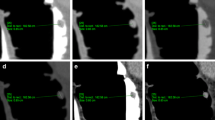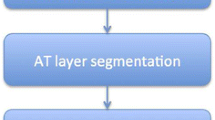Abstract
Objectives
To compare the performance of conventional versus spectral-based electronic stool cleansing for iodine-tagged CT colonography (CTC) using a dual-layer spectral detector scanner.
Methods
We retrospectively evaluated iodine contrast stool-tagged CTC scans of 30 consecutive patients (mean age: 69 ± 8 years) undergoing colorectal cancer screening obtained on a dual-layer spectral detector CT scanner. One reader identified locations of electronic cleansing artifacts (n = 229) on conventional and spectral cleansed images. Three additional independent readers evaluated these locations using a conventional cleansing algorithm (Intellispace Portal) and two experimental spectral cleansing algorithms (i.e., fully transparent and translucent tagged stool). For each cleansed image set, readers recorded the severity of over- and under-cleansing artifacts on a 5-point Likert scale (0 = none to 4 = severe) and readability compared to uncleansed images. Wilcoxon’s signed-rank tests were used to assess artifact severity, type, and readability (worse, unchanged, or better).
Results
Compared with conventional cleansing (66% score ≥ 2), the severity of overall cleansing artifacts was lower in transparent (60% score ≥ 2, p = 0.011) and translucent (50% score ≥ 2, p < 0.001) spectral cleansing. Under-cleansing artifact severity was lower in transparent (49% score ≥ 2, p < 0.001) and translucent (39% score ≥ 2, p < 0.001) spectral cleansing compared with conventional cleansing (60% score ≥ 2). Over-cleansing artifact severity was worse in transparent (17% score ≥ 2, p < 0.001) and translucent (14% score ≥ 2, p = 0.023) spectral cleansing compared with conventional cleansing (9% score ≥ 2). Overall readability was significantly improved in transparent (p < 0.001) and translucent (p < 0.001) spectral cleansing compared with conventional cleansing.
Conclusions
Spectral cleansing provided more robust electronic stool cleansing of iodine-tagged stool at CTC than conventional cleansing.
Key Points
• Spectral-based electronic cleansing of tagged stool at CT colonography provides higher quality images with less perception of artifacts than does conventional cleansing.
• Spectral-based electronic cleansing could potentially advance minimally cathartic approach for CT colonography. Further clinical trials are warranted.





Similar content being viewed by others
Abbreviations
- CTC:
-
Computed tomography colonography
- CTDIvol:
-
Computed tomography dose index
- HU:
-
Hounsfield units
- OC:
-
Optical colonoscopy
References
Siegel RL, Miller KD, Jemal A (2020) Cancer statistics, 2020. CA Cancer J Clin 70:7–30
Kumar V, Abbas AK, Aster JC, Robbins SL (2013) Robbins basic pathology. Elsevier/Saunders, Philadelphia
Winawer SJ, Zauber AG, Ho MN et al (1993) Prevention of colorectal cancer by colonoscopic polypectomy. The National Polyp Study Workgroup. N Engl J Med 329:1977–1981
Zauber AG, Winawer SJ, O'Brien MJ et al (2012) Colonoscopic polypectomy and long-term prevention of colorectal-cancer deaths. N Engl J Med 366:687–696
Bibbins-Domingo K, Grossman DC, Curry SJ et al (2016) Screening for colorectal cancer: US Preventive Services Task Force recommendation statement. JAMA 315:2564–2575
Wolf AMD, Fontham ETH, Church TR et al (2018) Colorectal cancer screening for average-risk adults: 2018 guideline update from the American Cancer Society. CA Cancer J Clin 68:250–281
Graser A, Stieber P, Nagel D et al (2009) Comparison of CT colonography, colonoscopy, sigmoidoscopy and faecal occult blood tests for the detection of advanced adenoma in an average risk population. Gut 58:241–248
Kim DH, Pickhardt PJ, Taylor AJ et al (2007) CT colonography versus colonoscopy for the detection of advanced neoplasia. N Engl J Med 357:1403–1412
Atkin W, Dadswell E, Wooldrage K et al (2013) Computed tomographic colonography versus colonoscopy for investigation of patients with symptoms suggestive of colorectal cancer (SIGGAR): a multicentre randomised trial. Lancet 381:1194–1202
Pooler BD, Kim DH, Weiss JM, Matkowskyj KA, Pickhardt PJ (2016) Colorectal polyps missed with optical colonoscopy despite previous detection and localization with CT Colonography. Radiology 278:422–429
van der Meulen MP, Lansdorp-Vogelaar I, Goede SL et al (2018) Colorectal cancer: cost-effectiveness of colonoscopy versus CT colonography screening with participation rates and costs. Radiology 287:901–911
Beebe TJ, Johnson CD, Stoner SM, Anderson KJ, Limburg PJ (2007) Assessing attitudes toward laxative preparation in colorectal cancer screening and effects on future testing: potential receptivity to computed tomographic colonography. Mayo Clin Proc 82:666–671
Liedenbaum MH, de Vries AH, Gouw CI et al (2010) CT colonography with minimal bowel preparation: evaluation of tagging quality, patient acceptance and diagnostic accuracy in two iodine-based preparation schemes. Eur Radiol 20:367–376
Kim DH, Hinshaw JL, Lubner MG, Munoz del Rio A, Pooler BD, Pickhardt PJ (2014) Contrast coating for the surface of flat polyps at CT colonography: a marker for detection. Eur Radiol 24:940–946
Yeh BM, Obmann MM, Westphalen AC et al (2018) Dual energy computed tomography scans of the bowel: benefits, pitfalls, and future directions. Radiol Clin N Am 56:805–819
Juchems MS, Ernst A, Johnson P, Virmani S, Brambs HJ, Aschoff AJ (2009) Electronic colon-cleansing for CT colonography: diagnostic performance. Abdom Imaging 34:359–364
Tachibana R, Näppi JJ, Ota J et al (2018) Deep learning electronic cleansing for single- and dual-energy CT colonography. Radiographics 38:2034–2050
Bräuer C, Lefere P, Gryspeerdt S et al (2018) CT colonography: size reduction of submerged colorectal polyps due to electronic cleansing and CT-window settings. Eur Radiol 28:4766–4774
Cai W, Yoshida H, Zalis ME, Näppi JJ, Harris GJ (2010) Informatics in radiology: electronic cleansing for noncathartic CT colonography: a structure-analysis scheme. Radiographics 30:585–602
Zalis ME, Perumpillichira J, Hahn PF (2004) Digital subtraction bowel cleansing for CT colonography using morphological and linear filtration methods. IEEE Trans Med Imaging 23:1335–1343
Serlie IW, Vos FM, Truyen R, Post FH, Stoker J, van Vliet LJ (2010) Electronic cleansing for computed tomography (CT) colonography using a scale-invariant three-material model. IEEE Trans Biomed Eng 57:1306–1317
Cai W, Kim SH, Lee JG, Yoshida H (2013) Informatics in radiology: dual-energy electronic cleansing for fecal-tagging CT colonography. Radiographics 33:891–912
Carmi R, Kafri G, Goshen L et al (2008) A unique noncathartic CT colonography approach by using two-layer dual-energy MDCT and a special algorithmic colon cleansing method 2008 IEEE Nuclear Science Symposium Conference Record, pp 4780-4783
Goshen L, Sosna J, Carmi R, Kafri G, Iancu I, Altman A (2008) An iodine-calcium separation analysis and virtually non-contrasted image generation obtained with single source dual energy MDCT2008 IEEE Nuclear Science Symposium Conference Record, pp 3868-3870
Anderson NG, Butler AP, Scott NJ et al (2010) Spectroscopic (multi-energy) CT distinguishes iodine and barium contrast material in MICE. Eur Radiol 20:2126–2134
Landis JR, Koch GG (1977) The measurement of observer agreement for categorical data. Biometrics 33:159–174
Obmann MM, An C, Schaefer A et al (2020) Improved sensitivity and reader confidence in CT colonography using dual-layer spectral CT: a phantom study. Radiology 297:99–107
Cai W, Lee JG, Zhang D, Kim SH, Zalis M, Yoshida H (2015) Electronic cleansing in fecal-tagging dual-energy CT colonography based on material decomposition and virtual colon tagging. IEEE Trans Biomed Eng 62:754–765
Tachibana R, Näppi JJ, Kim SH, Yoshida H (2015) Electronic cleansing for dual-energy CT colonography based on material decomposition and virtual monochromatic imaging. Proc SPIE Int Soc Opt Eng 9414:94140q
Eliahou R, Azraq Y, Carmi R, Mahgerefteh SY, Sosna J (2010) Dual-energy based spectral electronic cleansing in non-cathartic computed tomography colonography: an emerging novel technique. Semin Ultrasound CT MR 31:309–314
Taguchi N, Oda S, Imuta M et al (2018) Dual-energy computed tomography colonography using dual-layer spectral detector computed tomography: utility of virtual monochromatic imaging for electronic cleansing. Eur J Radiol 108:7–12
Brenner H, Stock C, Hoffmeister M (2014) Effect of screening sigmoidoscopy and screening colonoscopy on colorectal cancer incidence and mortality: systematic review and meta-analysis of randomised controlled trials and observational studies. BMJ 348:g2467
Brenner H, Chang-Claude J, Jansen L, Knebel P, Stock C, Hoffmeister M (2014) Reduced risk of colorectal cancer up to 10 years after screening, surveillance, or diagnostic colonoscopy. Gastroenterology 146:709–717
Stoop EM, de Haan MC, de Wijkerslooth TR et al (2012) Participation and yield of colonoscopy versus non-cathartic CT colonography in population-based screening for colorectal cancer: a randomised controlled trial. Lancet Oncol 13:55–64
Sali L, Mascalchi M, Falchini M et al (2016) Reduced and full-preparation CT colonography, fecal immunochemical test, and colonoscopy for population screening of colorectal cancer: a randomized trial. J Natl Cancer Inst 108:djv319
van Gelder RE, Birnie E, Florie J et al (2004) CT colonography and colonoscopy: assessment of patient preference in a 5-week follow-up study. Radiology 233:328–337
Acknowledgements
The authors would like to thank Liran Goshen, Amar Dhanantwari, Jörg Sabcynski, and Tobias Klinder (of Philips CT, Clinical Science, and Research, respectively) for numerous fruitful discussions, algorithmic exploration, and the preparation of the CT images using conventional electronic cleansing.
Funding
This study has received funding by a grant from Philips Healthcare, Cleveland, OH, USA, and the National Institutes of Health under Award Number R01CA226868. The content is solely the responsibility of the authors and does not necessarily represent the official views of Philips Healthcare or the National Institutes of Health. The funders had no role in the design of the study; in the collection, analyses, or interpretation of data; in the writing of the manuscript, and in the decision to publish the results.
Author information
Authors and Affiliations
Corresponding author
Ethics declarations
Guarantor
The scientific guarantor of this publication is Benjamin Yeh, MD (Department of Radiology and Biomedical Imaging, University of California, San Francisco, 513 Parnassus Ave, San Francisco, CA 94143; Benjamin.Yeh@ucsf.edu).
Conflict of interest
Rafael Wiemker, PhD, and Eddy Wong, PhD, were employed by Philips Healthcare.
Statistics and biometry
No complex statistical methods were necessary for this paper.
Informed consent
Written informed consent was waived by the Institutional Review Board.
Ethical approval
Institutional Review Board approval was obtained.
Methodology
• retrospective
• case-control study
• performed at one institution
Additional information
Publisher’s note
Springer Nature remains neutral with regard to jurisdictional claims in published maps and institutional affiliations.
Supplementary Information
ESM 1
(DOCX 43 kb)
Rights and permissions
About this article
Cite this article
Grosu, S., Wiemker, R., An, C. et al. Comparison of the performance of conventional and spectral-based tagged stool cleansing algorithms at CT colonography. Eur Radiol 32, 7936–7945 (2022). https://doi.org/10.1007/s00330-022-08831-2
Received:
Revised:
Accepted:
Published:
Issue Date:
DOI: https://doi.org/10.1007/s00330-022-08831-2




